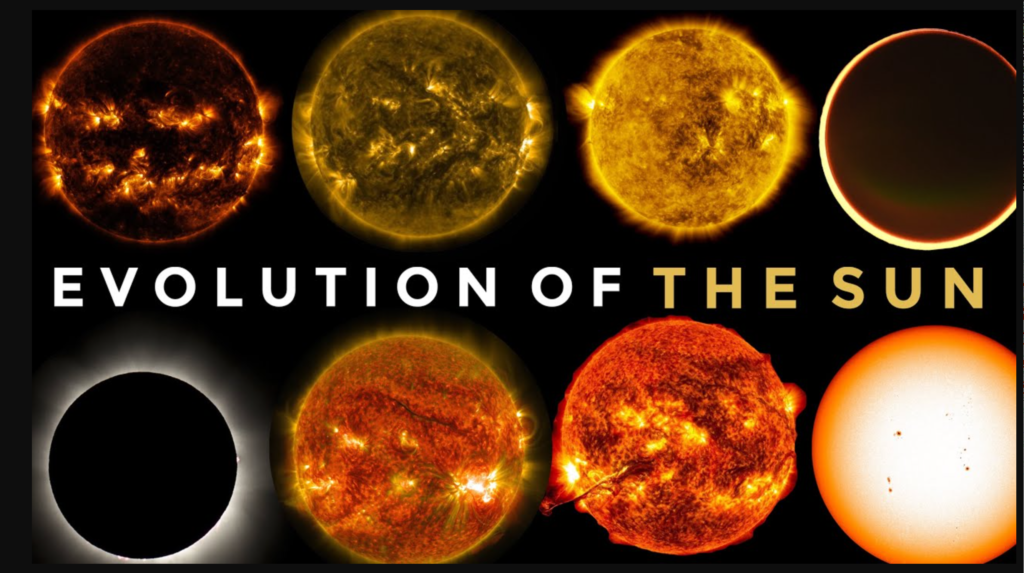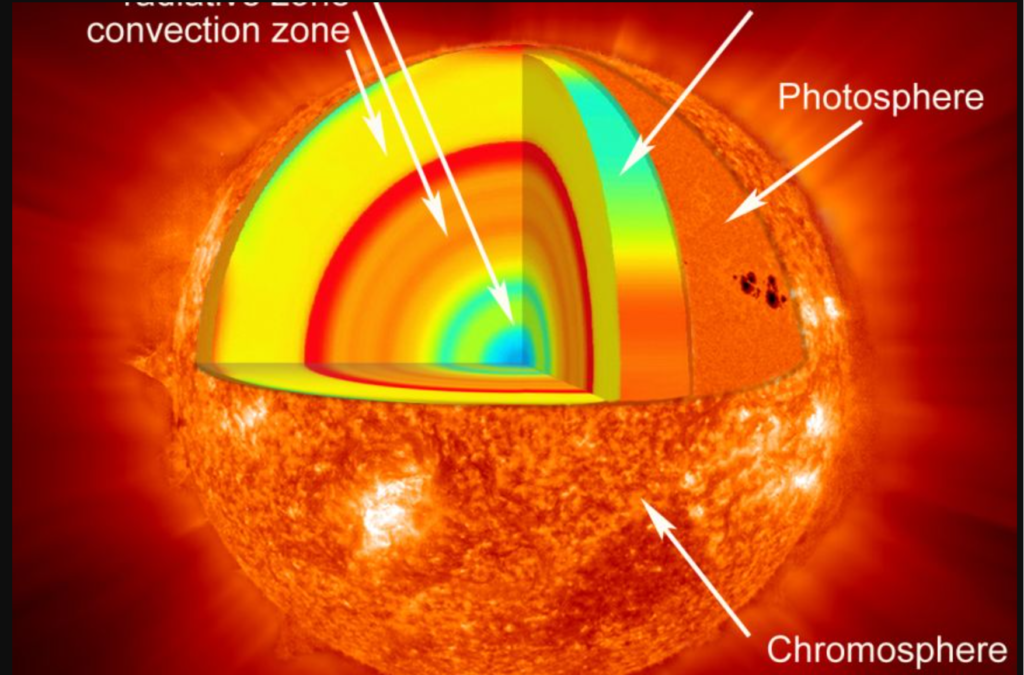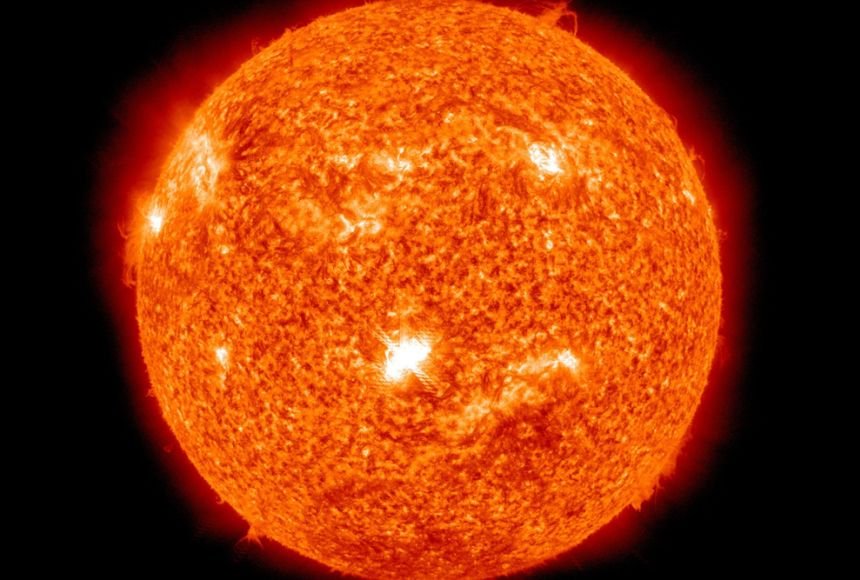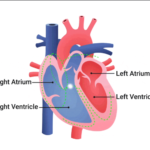The sun is a typical star, one of the Milky Way’s about 100 billion. The sun has a huge impact on our world because it controls the seasons, climate, weather patterns, ocean currents, and photosynthesis, which allows plants to survive.
The sun
The sun is a typical star, one of the Milky Way’s about 100 billion. The sun has a huge impact on our world because it controls the seasons, climate, weather patterns, ocean currents, and photosynthesis, which allows plants to survive. Life on Earth could not live without the heat and light emitted by the sun.
The sun originated as a mostly hydrogen and helium-dominated chemical cloud around 4.5 billion years ago. The molecular cloud was energised when a shockwave from a nearby supernova collided with it. As the molecular cloud started to compress, certain gaseous regions gave way due to the force of gravity. One of these sections collapsed, and as the pressure increased, it started to rotate and heat up. Within the core of this hot, whirling mass, a large portion of the hydrogen and helium still existed. The gases eventually heated up to a point where nuclear fusion could start, creating our solar system’s sun.
Other portions of the molecular cloud formed into planets, asteroids, comets, and other bodies in our solar system when they cooled into a disc around the newly formed sun.

About 150 million kilometres, or 93 million miles, separate Earth from the sun. Astronomers and astrophysicists use this distance, known as an astronomical unit (AU), as a standard unit of measurement.
Light speed, or how long it takes a photon of light to travel from the sun to Earth, can be used to quantify an astronomical unit (AU). The light travels from the sun to Earth in approximately eight minutes and 19 seconds.
The sun’s radius, or the distance between its outermost point and its centre, is approximately 700,000 kilometres (432,000 miles). That distance is equivalent to around 109 times the radius of the Earth. The sun is far more massive than Earth in addition to having a significantly bigger radius. With a mass greater than 333,000 times that of Earth, the sun makes up approximately 99.8% of the solar system’s total mass.
Also read :Facts About Aurora Borealis: How The Northern Lights Operate
Composition
The sun is composed of a fiery mixture of gases. In reality, these gases exist as plasma. Similar to gas, plasma is a state of matter where the majority of the particles are ionised. This indicates if there are more or fewer electrons in the particles.
Nuclear fusion is the process by which hydrogen, which makes up around three quarters of the sun, continuously combines to form helium. The remaining quarter is virtually entirely composed of helium. Other gases and metals that make up a very small portion (1.69 percent) of the sun’s mass include iron, nickel, oxygen, silicon, sulphur, magnesium, carbon, neon, calcium, and chromium. Despite its small percentage of 1.69 percent, its mass is still 5,628 times more than that of Earth.

The sun is not a dense object. Its borders are not as clearly defined as those of stony worlds like Earth. Rather, hydrogen and helium make up nearly all of the layers that make up the sun. The roles that these gases play in each layer of the sun are distinct, and the layers are determined by how much of the sun’s total radius each layer makes up.
A magnetic field permeates and somewhat governs the sun. Three intricate mechanisms work together to define the magnetic field of the sun: the sun’s ability to conduct electricity, layers that revolve at different rates, and the circular electric current that flows through the sun. Magnetic field lines form tiny loops close to the surface near the sun’s equator. Thousands of km separate the magnetic field lines that pass through the poles from the opposing pole.
Similar to Earth, the sun revolves around its own axis. It takes the sun between 25 and 35 days to complete one anticlockwise rotation.
The Milky Way’s galactic centre is the location of the sun’s orbit. Its orbit is spaced 24,000–26,000 light-years from the centre of the galaxy. It takes the sun between 225 million and 250 million years to complete one orbit of the galactic centre.
Electromagnetic Radiation
Electromagnetic radiation (EMR) is the sun’s energy that reaches Earth at the speed of light.
There are waves of various frequencies and wavelengths that make up the electromagnetic spectrum.
A wave’s frequency indicates how many times it repeats in a specific amount of time. High-frequency waves are those with very small wavelengths that repeat multiple times in a given amount of time. Low-frequency waves, however, have wavelengths that are somewhat longer.
We are unable to see the great bulk of electromagnetic radiation that originate from the sun. The sun emits ultraviolet radiation (UV rays), gamma rays, and x-rays, which are the highest frequency waves. The Earth’s atmosphere absorbs almost all of the most dangerous UV radiation. Sunburn can result from less powerful UV photons that pass through the atmosphere.

Infrared radiation, which has waves with a far lower frequency, is also emitted by the sun. The majority of solar heat is absorbed as infrared radiation.
The visible spectrum, which includes all the colours that humans can perceive, is positioned between infrared and ultraviolet light. The colours violet, which is closest to UV light, and red, which is closest to infrared light, have the shortest wavelengths.
Since the sun is white, every colour in the visible spectrum is present in it. Because the blue light the sun releases has a shorter wavelength and is scattered in the atmosphere—the same process that gives the sky its blue appearance—the sun appears orangish-yellow.
However, because the sun’s colours are found in the yellow-green region of the electromagnetic spectrum, astronomers refer to it as a “yellow dwarf” star.
Evolution of the Sun
Despite having supported all life on Earth, the sun will eventually fade. After all, the sun has been around for almost 4.5 billion years.
The process that gradually alters the sun’s composition is nuclear fusion, which also produces the heat and light necessary for life on Earth. The sun continuously converts about 620 million metric tonnes of hydrogen into helium each second by nuclear fusion, depleting the hydrogen in its core.
Approximately 74% of the sun’s core contains hydrogen at this point in its existence. The sun will use up most of its hydrogen over the course of the next five billion years, and helium will take over as its primary fuel.

The sun will transition from being a “yellow dwarf” to a “red giant” during those five billion years. The sun’s core will compress and heat up when nearly all of the hydrogen has been used, which will increase the amount of nuclear fusion that occurs. The additional energy will cause the sun’s outer layers to expand.
When the sun enlarges to a radius of around 200 times its present size, Mercury and Venus will be engulfed.
Astrophysicists disagree as to whether Earth’s orbit would widen and eventually surpass the solar radius, or if the sun would swallow our planet whole.
The sun will disperse its energy over a broader surface area as it grows, which will ultimately chill the star. The sun will appear redder—a red giant—as a result of this cooling.
The centre of the sun eventually achieves a temperature of roughly 100 million Kelvin degrees, or nearly 100 million degrees Celsius or 180 million degrees Fahrenheit, which is the standard scientific scale for determining temperature. Helium will start to fuse at this temperature to produce carbon, a much heavier element. Intense solar wind and other solar activity will result from this, eventually upsetting the sun’s outermost layers. There will be no more red gigantic phases. There will be nothing but the sun’s carbon core, which is a “white dwarf” that cannot produce or release energy.
Sun’s Structure
The core, radiative zone, convective zone, photosphere, chromosphere, and corona are the six layers that make up the sun.

Core :
The sun’s core is a massive furnace that is more than a thousand times larger than Earth and more than ten times denser than lead. Above 15.7 million kelvin, or 15.7 million degrees Celsius, or 28 million degrees Fahrenheit, are temperatures found in the core. The radius of the sun’s core is around 25% of its total radius.
The only region in which nuclear fusion reactions can occur is the core. The nuclear energy produced there heats the other layers of the sun. In a strong collision, the protons of hydrogen atoms fuse, or unite, to form helium atoms.
This event, called a proton-proton (PP) chain reaction, releases a tremendous amount of energy. A solar fusion reaction releases a lot more energy in a second than hundreds of thousands of hydrogen bomb explosions do.
Photons and neutrinos are the two forms of energy created during nuclear fusion in the core. The sun’s light, heat, and energy are carried by and released from these particles. The smallest unit of electromagnetic energy, including light, is a photon. Neutrinos make up only 2% of the sun’s total energy and are more challenging to detect. Both photons and neutrinos are constantly released by the sun in all directions.
Radiative Zone :
About 25% of the radius is occupied by the sun’s radiative zone, which extends to roughly 70% of the radius. Between seven million K (12 million°F or 7 million°C) and two million K (2 million°C or 4 million°F), there is a sharp drop in heat from the core within this large zone.
Thermal radiation is the method through which energy is transported in the radiative zone. Photons generated in the core during this process travel a short distance, get absorbed by an ion nearby, get released by that ion, and then get absorbed again by another ion. This process can be carried out by one photon for about 200,000 years!

Transition Zone: Tachocline
The tachocline is the transition zone that exists between the radiative zone and the convective zone, the layer below. The uneven rotation of the sun creates this area.
When an object’s constituent pieces rotate at various speeds, this is known as differential rotation. The gases that make up the sun are subject to various processes at various latitudes and layers. For example, the equator of the sun revolves far more quickly than the poles.
In the tachocline, the sun’s rotation rate fluctuates drastically.
Convective Zone
At around 70 percent of the sun’s radius, the convective zone begins. In this zone, the sun’s temperature is not hot enough to transfer energy by thermal radiation. Instead, it transfers heat by thermal convection through thermal columns.
Similar to water boiling in a pot, or hot wax in a lava lamp, gases deep in the sun’s convective zone are heated and “boil” outward, away from the sun’s core, through thermal columns. When the gases reach the outer limits of the convective zone, they cool down, and plunge back to the base of the convective zone, to be heated again.
Photosphere
The sun’s visible, brilliant yellow “surface” is known as the photosphere. The photosphere has a thickness of around 400 km (250 mi), and its temperature can reach up to 6,000 K (5,700°C, 10,300°F).
In the photosphere, the convection zone’s thermal columns may be seen bubbling like boiling muesli. The tops of the columns appear as granules crammed across the sun through large telescopes. The hot gas rising through a thermal column is the bright centre of each granule. The cool gas returning to the bottom of the convective zone descends through the black edges of the granules.

Despite having the appearance of tiny grains, the tops of the thermal columns are typically more than 1,000 kilometres (621 miles) in diameter. The majority of thermal columns last between eight and twenty minutes before dissolving and forming new ones. Additionally, there are “supergranules” that have a maximum diameter of 30,000 km (18,641 mi) and a maximum duration of 24 hours.
Although they originate from processes and disturbances in other layers of the sun, sunspots, solar flares, and solar prominences form in the photosphere.
Solar Wind
A stream of incredibly hot, charged particles known as the solar wind emerges from the sun’s upper atmosphere. This indicates that the sun loses mass equivalent to Earth every 150 million years. The sun has only lost 0.01 percent of its entire mass due to solar wind, even at this rate of loss.
The solar wind is directed in every direction. For almost 10 billion km, it keeps travelling at that pace (six billion miles).

In the vicinity of the poles, some solar wind particles enter Earth’s upper atmosphere after slipping past the planet’s magnetic field. These charged particles cause auroras, or the vibrant light displays known as the Northern and Southern Lights, when they clash with the atmosphere of our planet. Solar storms can also be caused by solar winds. These storms have the ability to interfere with satellites and take out Earth’s power networks.
The heliosphere, a vast bubble of charged particles around the solar system, is filled with solar wind.
Eventually, the solar wind slows down close to the heliosphere’s edge, reaching a boundary known as the heliopause. This border divides solar system matter and energy from that of nearby star systems and the interstellar medium.
The area between star systems is known as the interstellar medium. After travelling billions of km, the solar wind is unable to continue past the interstellar medium.
Also read :Ozone Layer: A Hole In The Earth’s Protective Shield




































